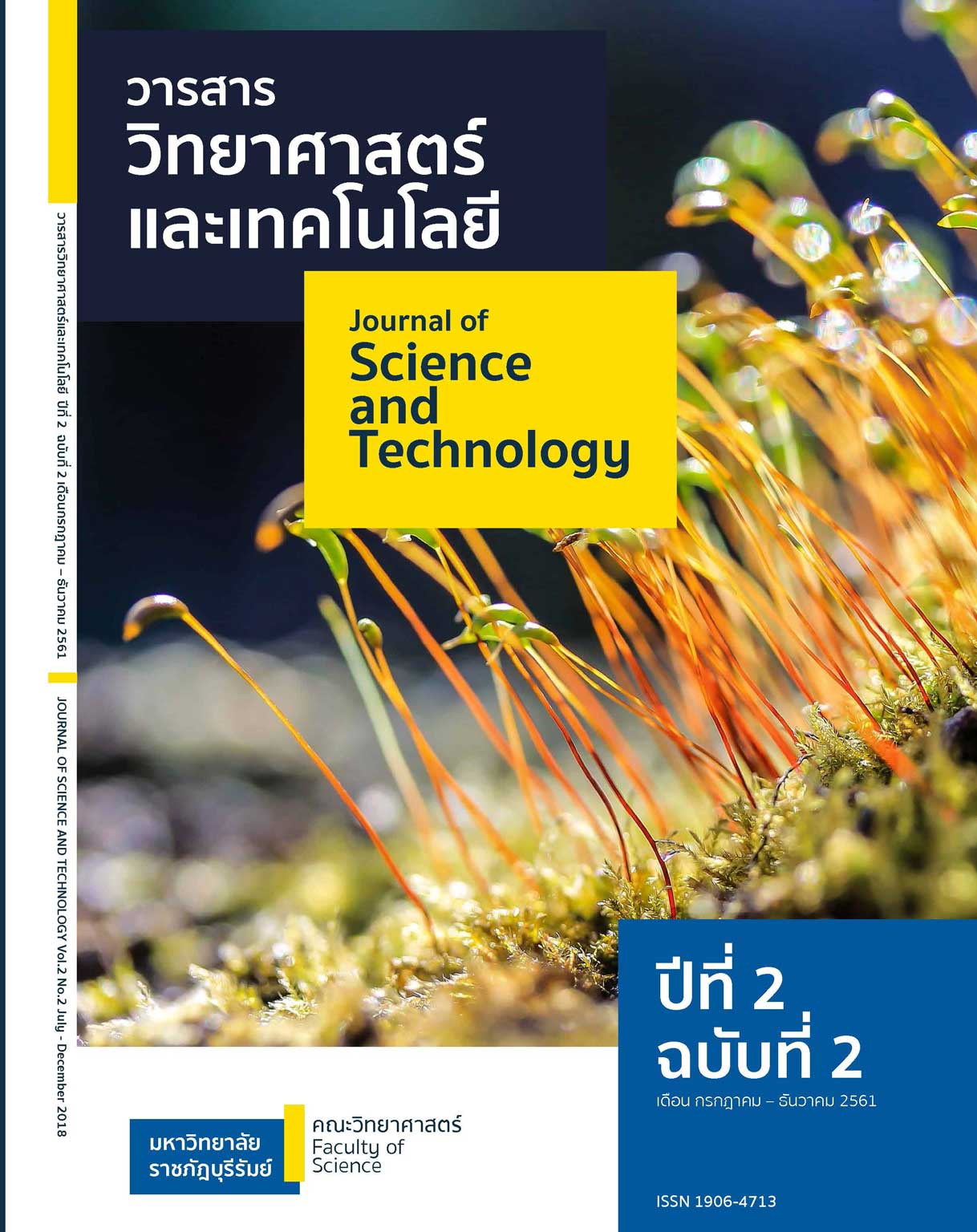ประสิทธิภาพของเซลล์แสงอาทิตย์ชนิดสีย้อมไวแสง : สีย้อมไวแสงจากธรรมชาติ
Main Article Content
บทคัดย่อ
วัตถุประสงค์ของการศึกษานี้เพื่อศึกษาการใช้สีย้อมธรรมชาติเป็นตัวไวแสงในเซลล์ แสงอาทิตย์ชนิดสีย้อมไวแสง โดยทําการสกัดสีย้อมจากธรรมชาติ เช่น ดอกไม้ ใบไม้ ผลไม้ และเปลือกไม้ เป็นต้น เพื่อทดสอบความสามารถในการเป็นสีย้อมไวแสงในเซลล์แสงอาทิตย์ ผลการทดสอบการดูดกลืนแสงของสีย้อมที่สกัดได้ พบว่า สารสกัดที่จากพืชทุกชนิดมีการ ดูดกลืนแสงในช่วงแสงวิสิเบิล และจากการศึกษาประสิทธิภาพของเซลล์แสงอาทิตย์พบว่าสาร สกัดจากพืช 3 ชนิด สามารถวัดประสิทธิภาพได้คือ ชมพู่มะเหมี่ยว อัญชัน และ ฝาง ซึ่งมี ประสิทธิภาพการเปลี่ยนพลังงานแสงให้เป็นไฟฟ้าเท่ากับ 0.1648%, 0.3377% และ 0.1690% ตามลําดับ เนื่องจากการสีย้อมจากธรรมชาติสามารถเตรียมได้ง่าย มีค่าสัมประสิทธิ์ การดูดกลืนแสงสูง หาได้ทั่วไปและมีราคาถูก ทําให้เป็นทางเลือกที่ดีทางหนึ่งสําหรับการ นํามาใช้ในเซลล์แสงอาทิตย์ชนิดสีย้อมไวแสง
Article Details
เนื้อหาและข้อมูลในบทความที่ลงตีพิมพ์ในวารสารวารสารวิทยาศาสตร์และเทคโนโลยีถือเป็นข้อคิดเห็นและความรับผิดชอบของผู้เขียนบทความโดยตรงซึ่งกองบรรณาธิการวารสาร ไม่จำเป็นต้องเห็นด้วย หรือร่วมรับผิดชอบใด ๆ
บทความ ข้อมูล เนื้อหา รูปภาพ ฯลฯ ที่ได้รับการตีพิมพ์ในวารสารวารสารวิทยาศาสตร์และเทคโนโลยีถือเป็นลิขสิทธิ์ของวารสารวารสารวิทยาศาสตร์และเทคโนโลยีหากบุคคลหรือหน่วยงานใดต้องการนำทั้งหมดหรือส่วนหนึ่งส่วนใดไปเผยแพร่ต่อหรือเพื่อกระทำการใด ๆ จะต้องได้รับอนุญาตเป็นลายลักษณ์อักษรจากวารสารวารสารวิทยาศาสตร์และเทคโนโลยี ก่อนเท่านั้น
References
Chen L, et al. (2014). “Improving the Performance of Dye-sensitized Solar Cells with TiOz/graphene/TiO sandwich Structure,” Nanoscale Research Letters. 9 : 380.
Fang X, at el. (2014). “Graphene-compositing Optimization of the Properties of Dye-sensitized Solar Cells,” Solar Energy. 101 : 176-181.
Hasan R, et al. (2015). “Ga Doped RGO-TiOzcomposite on an ITO Surface Electrode for Investigation of Photo Electrocatalytic Activity under Visible Light Irradiation,” New J. Chem. 39 : 369-376.
Lia G, et al. (2011). “Preparation and Photoelectrochemical Performance of Ag/graphene/TiOz Composite Film,” Applied Surface Science. 257 : 6568-6572.
Li L, et al. (2014). “A Green Method to Prepare Pd-Ag Nanoparticles Supported on Reduced Graphene Oxide and Their Electrochemical Catalysis of Methanol and Ethanol Oxidation,” Journal of Power Sources. 263: 1321.
Muthoosamy K, et al. (2015). “Exceedingly Biocompatible and Thin-layered Reduced Graphene Oxide Nanosheets Using an Eco-friendly Mushroom Extract Strategy,” International Journal of Nanomedicine. 10 : 15051519.
Tang Y, et al. (2010). “Incorporation of Graphenes in Nanostructured TiO2 Films via Molecular Grafting for Dye-Sensitized Solar Cell Application,” American Chemical Society. 4: 3482-3488.
Tripathi B, et al. (2014). “Investigating the Role of Graphene in the Photovoltaic Performance Improvement of Dye-sensitized Solar Cell,” Materials Science and Engineering. 190 : 111-118.
Tsai C, Fei P and Wu W. (2015). “Enhancing the Efficiency and Charge Transport Characteristics of Dye-Sensitized Solar Cells by Adding Graphene Nanosheets to TiO2 Working Electrodes,” Electrochimica Acta. 165 : 356-364.
Tsai C, et al. (2015). “Investigation of Graphene Nanosheets as Counter Electrodes for Efficient Dye-sensitized Solar Cells,” Organic Electronics. 17:57-65.
Wang Q, et al. (2015). “Effect of the Reactivity and Porous Structure of Expanded Graphite (EG) on Microstructure and Properties of Al2O3-C Refractories,” Journal of Alloys and Compounds. 645 : 388-397.
Yue G, et al. (2013). “Platinum/graphene Hybrid Film as a Counter Electrode for Dye-sensitized Solar Cells,” Electrochimica Acta. 92: 64-70.
Zhua M, et al. (2014). “An Investigation on the Hotoelectrochemical Properties of Dye-sensitized Solar Cells Based on Graphenee TiO2 Composite Photoanodes,” Journal of Power Sources. 262 : 349-355.
Zhao J, et al. (2015). “Improving the Photovoltaic Performance of Dye sensitized Solar Cell by Graphene/titania Photoanode,” Electrochimica Acta. 156 : 261-266.

